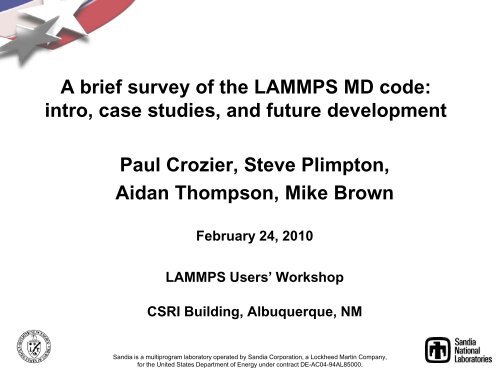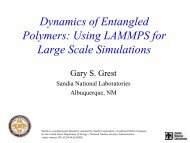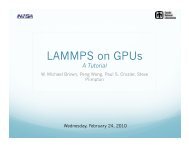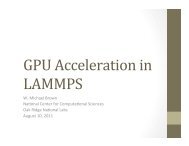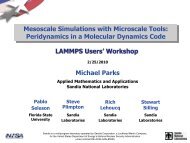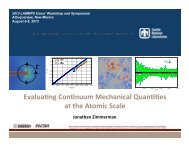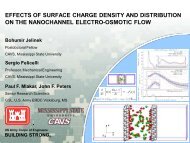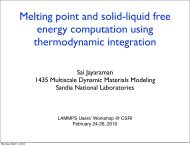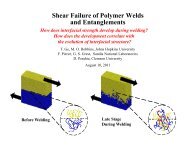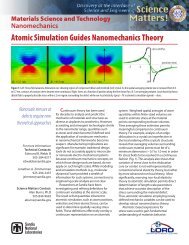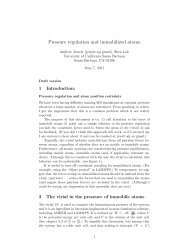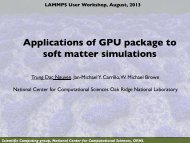LAMMPS for beginners - Sandia National Laboratories
LAMMPS for beginners - Sandia National Laboratories
LAMMPS for beginners - Sandia National Laboratories
Create successful ePaper yourself
Turn your PDF publications into a flip-book with our unique Google optimized e-Paper software.
A brief introduction to MD• MD: molecular dynamics• F = ma• Classical dynamics• Rapidly grown in popularity and use in research• Computationally intensive, especially computation ofnonbonded interactions• Uses <strong>for</strong>ce fields: mathematical models of interatomicinteractions
MD uses empirical <strong>for</strong>ce fields• Particles interact via empirical potentials– analytic equations, fast to compute– coefficients fit to expt or quantum calcs• Potential energy = Φ = f(x)• Force = -Grad Φ• Pair-wise <strong>for</strong>ces– Van der Waals (dipole-dipole)– Coulombic (charge-charge)• Many-body <strong>for</strong>ces– EAM, Tersoff, bond-order, ReaxFF• Molecular <strong>for</strong>ces– springs, torsions, dihedrals, ...• Long-range Coulombic <strong>for</strong>ces– Ewald, particle-mesh methods, FFTs
MD in the Middle• Quantum mechanics– electronic degrees of freedom, chemical reactions– Schrodinger equation, wave functions– sub-femtosecond timestep, 1000s of atoms, O(N 3 )• Atomistic models– molecular dynamics (MD), Monte Carlo (MC)– point particles, empirical <strong>for</strong>ces, Newton's equations– femtosecond timestep, millions of atoms, O(N)10 -15 s yearsTimeQMMDMESOFEADesign• Mesoscale to Continuum– finite elements or finite difference on grids– coarse-grain particles: DPD, PeriDynamics, ...– PDEs, Navier-Stokes, stress-strain– microseconds seconds, microns meters, O(N 3/2 )ÅDistancem
Algorithmic Issues in MD• Speed– parallel implementation• Accuracy– long-range Coulombics• Time scale– slow versus fast degrees of freedom• Length scale– coarse-graining
Classical MD in Parallel• MD is inherently parallel– <strong>for</strong>ces on each atom can be computed simultaneously– X and V can be updated simultaneously• Most MD codes are parallel– via distributed-memory message-passing paradigm (MPI)• Computation scales as N = number of atoms– ideally would scale as N/P in parallel• Can distribute:– atoms communication = scales as N– <strong>for</strong>ces communication = scales as N/sqrt(P)– space communication = scales as N/P or (N/P) 2/3
Parallelism via Spatial-Decomposition• Physical domain divided into 3d boxes, one per processor• Each proc computes <strong>for</strong>ces on atoms in its boxusing info from nearby procs• Atoms "carry along" molecular topologyas they migrate to new procs• Communication vianearest-neighbor 6-way stencil• Optimal scaling <strong>for</strong> MD: N/Pso long as load-balanced• Computation scales as N/P• Communication scalessub-linear as (N/P) 2/3(<strong>for</strong> large problems)• Memory scales as N/P
A brief introduction to <strong>LAMMPS</strong><strong>LAMMPS</strong>: Large-scale Atomic/Molecular Massively Parallel Simulator• Massively parallel, general purpose particle simulation code.• Developed at <strong>Sandia</strong> <strong>National</strong> <strong>Laboratories</strong>, withcontributions from many labs throughout the world.• Over 170,000 lines of code.• 14 major releases since September 2004• Continual (many times per week) releases of patches (bugfixes and patches)• Freely available <strong>for</strong> download under GPLlammps.sandia.govTens of thousands of downloads since September 2004Open source, easy to understand C++ codeEasily extensible
How to download, install, and use <strong>LAMMPS</strong>• Download page:lammps.sandia.gov/download.html• Installation instructions:lammps.sandia.gov/doc/Section_start.htmlgo to lammps/srctype “make your_system_type”• To per<strong>for</strong>m a simulation:lmp < my_script.in
How to get help with <strong>LAMMPS</strong>1. Excellent User’s Manual:http://lammps.sandia.gov/doc/Manual.htmlhttp://lammps.sandia.gov/doc/Section_commands.html#3_52. Search the web: can include “lammps-users” as a search keyword tosearch old e-mail archives3. Try the wiki: http://lammps.wetpaint.com/4. Send e-mail to the user’s e-mail list:http://lammps.sandia.gov/mail.html5. Contact <strong>LAMMPS</strong> developers: http://lammps.sandia.gov/authors.htmlSteve Plimpton, sjplimp@sandia.govAidan Thompson, athomps@sandia.govMike Brown, wmbrown@sandia.govPaul Crozier, pscrozi@sandia.gov
Force fields available in <strong>LAMMPS</strong>• Biomolecules: CHARMM, AMBER, OPLS, COMPASS (class 2),long-range Coulombics via PPPM, point dipoles, ...• Polymers:all-atom, united-atom, coarse-grain (bead-spring FENE),bond-breaking, …• Materials:EAM and MEAM <strong>for</strong> metals, Buckingham, Morse, Yukawa,Stillinger-Weber, Tersoff, AI-REBO, Reaxx FF, ...• Mesoscale:granular, DPD, Gay-Berne, colloidal, peri-dynamics,DSMC ...• Hybrid:can use combinations of potentials <strong>for</strong> hybrid systems:water on metal, polymers/semiconductor interface,colloids in solution, …
Easily add your own <strong>LAMMPS</strong> feature• New user or new simulation always want new feature not in code• Goal: make it as easy as possible <strong>for</strong> us and others to add new featurescalled “styles” in <strong>LAMMPS</strong>:particle type, pair or bond potential, scalar or per-atom computation"fix": BC, <strong>for</strong>ce constraint, time integration, diagnostic, ...input command: create_atoms, set, run, temper, ...over 75% of current 170K+ lines of <strong>LAMMPS</strong> is add-on styles• Enabled by C++"virtual" parent class <strong>for</strong> all pair potentialsdefines interface: compute(), coeff(), restart(), ...add feature: add 2 lines to header file, add files to src dir, re-compilefeature won't exist if not used, won't conflict with rest of code• Of course, someone has to write the code <strong>for</strong> the feature!
<strong>LAMMPS</strong>’s parallel per<strong>for</strong>mance• Fixed-size (32K atoms) and scaled-size (32K atoms/proc)parallel efficiencies• Metallic solid with EAM potential• Billions of atoms on 64K procs of Blue Gene or Red Storm• Opteron processor speed: 5.7E-6 sec/atom/step (0.5x <strong>for</strong> LJ,12x <strong>for</strong> protein)
Particle-mesh Methods <strong>for</strong> Coulombics• Coulomb interactions fall off as 1/r so require long-range <strong>for</strong> accuracy• Particle-mesh methods:partition into short-range and long-range contributionsshort-range via direct pairwise interactionslong-range:interpolate atomic charge to 3d meshsolve Poisson's equation on mesh (4 FFTs)interpolate E-fields back to atoms• FFTs scale as NlogN if cutoff is held fixed
Parallel FFTs• 3d FFT is 3 sets of 1d FFTsin parallel, 3d grid is distributed across procsper<strong>for</strong>m 1d FFTs on-processornative library or FFTW (www.fftw.org)1d FFTs, transpose, 1d FFTs, transpose, ..."transpose” = data transfertransfer of entire grid is costly• FFTs <strong>for</strong> PPPM can scale poorlyon large # of procs and on clusters• Good news: Cost of PPPM is only ~2x more than 8-10 Angstrom cutoff
Time Scale of Molecular Dynamics• Limited timescale is most serious drawback of MD• Timestep size limited by atomic oscillations:– C-H bond = 10 fmsec ½ to 1 fmsec timestep– Debye frequency = 10 13 2 fmsec timestep• A state-of-the-art “long” simulation is nanoseconds toa microsecond of real time• Reality is usually on a much longer timescale:– protein folding (msec to seconds)– polymer entanglement (msec and up)– glass relaxation (seconds to decades)
Extending Timescale• SHAKE = bond-angle constraints, freeze fast DOF– up to 2-3 fmsec timestep– rigid water, all C-H bonds– extra work to en<strong>for</strong>ce constraints• rRESPA = hierarchical time stepping, sub-cycle on fast DOF– inner loop on bonds (0.5 fmsec)– next loop on angle, torsions (3-4 body <strong>for</strong>ces)– next loop on short-range LJ and Coulombic– outer loop on long-range Coulombic (4 fmsec)• Rigid body time integration via quaternions– treat groups of atom as rigid bodies (portions of polymer or protein)– 3N DOF 6 DOF– save computation of internal <strong>for</strong>ces, longer timestep
Length Scale of Molecular Dynamics• Limited length scale is 2nd most seriousdrawback of MD coarse-graining• All-atom:∆t = 0.5-1.0 fmsec <strong>for</strong> C-HC-C distance = 1.5 Angscutoff = 10 Angs• United-atom:# of interactions is 9x less∆t = 1.0-2.0 fmsec <strong>for</strong> C-Ccutoff = 10 Angs20-30x savings over all-atom• Bead-Spring:2-3 C per bead∆t fmsec mapping is T-dependent2 1/6 σ cutoff 8x in interactionscan be considerable savings over united-atom
Atomistic Scale Models with <strong>LAMMPS</strong>• Interfaces in melting solids• Adhesion properties of polymers• Shear response in metals• Tensile pull on nanowires• Surface growth on mismatched lattice• Shock-induced phase trans<strong>for</strong>mations• Silica nanopores <strong>for</strong> water desalination• Coated nanoparticles in solution and at interfaces• Self-assembly (2d micelles and 3d lipid bilayers)• Rhodopsin protein isomerization
Melt Interface in NiAl• Mark Asta (UC Davis) and Jeff Hoyt (<strong>Sandia</strong>)• Careful thermostatting and equilibration of alloy system• Track motion and structure of melt interface
Polymer Adhesive Properties• Mark Stevens and Gary Grest (<strong>Sandia</strong>)• Bead/spring polymer model, allow <strong>for</strong> bond breaking
Shear Response of Cu Bicrystal• David McDowell group (GA Tech)• Defect <strong>for</strong>mation, stress relaxation, energetics of boundary region
Coated Nanoparticles at Interfaces• Matt Lane, Gary Grest (<strong>Sandia</strong>)• S sites on Au nanoparticle, alkane-thiol chains,methyl-terminated, 3 ns simwaterdecane
3d Membrane Self-Assembly• Mark Stevens (<strong>Sandia</strong>)• Coarse-grain lipid model in monomeric solvent• Angle terms <strong>for</strong> rigidity• Hydrophilic head-group & solvent, hydrophobic tail• 100Ks of particles <strong>for</strong> millions of timesteps• Bilayer & vesicle <strong>for</strong>mation15K monomers <strong>for</strong> 1M steps
Membrane Fusion• Gently push together ...
• Mike Brown (<strong>Sandia</strong>)Aspherical Nanoparticles• Ellipsoidal particles interacting via Gay-Berne potentials(LC), LJ solvent• Nanodroplet <strong>for</strong>mation in certain regimes of phase space
• Multiple rigid bodies• Quaternion integration• Brownian dynamics• Self-assembly phasesRigid Nanoparticle Self-Assembly(Sharon Glotzer et al., Nano Letters, 3, 1341 (2003).
<strong>LAMMPS</strong>’s Reactive Force Fields CapabilityWhy Reactive Force Fields?• Material behavior often dominated by chemical processes• HE, Complex Solids, Polymer Aging• Quantum methods limited to hundreds of atoms• Ordinary classical <strong>for</strong>ce fields limited accuracy• We need to have the best of both worlds ⇒Reactive <strong>for</strong>ce fieldsWhy build Reactive Force Fields into <strong>LAMMPS</strong>?• Reactive <strong>for</strong>ce fields typically exist as custom serial MD codes• <strong>LAMMPS</strong> is a general parallel MD code
<strong>LAMMPS</strong>+ReaxFF enables direct simulation of detailed initialenergy propagation in HE–Improved understanding of sensitivity will aid development of morereliable microenergetic components–Goal: Identify the specific atomistic processes that causeorientation-dependent detonation sensitivity in PETN–Thermal excitation simulations used as proof-of-concept–Collaborating with parallel DoD-funded ef<strong>for</strong>t at Caltech (BillGoddard, Sergey Zybin)–Now running multi-million atom shock-initiated simulations withdifferent orientationsComplex molecular structure of unreactedtetragonal PETN crystal, C (gray), N (blue), O(red), and H (white).–Contracted Grant Smith to extend his HMX/RDX non-reactive <strong>for</strong>cefield to PETNPropagation of reaction front due to thermal excitation of a thin layer at the center of the sample <strong>for</strong> 10picoseconds. Top: atoms colored by potential energy. Bottom: atoms colored by temperature (atoms below1000K are not shown).
[1000]MD Simulation of Shock-induced StructuralPhase Trans<strong>for</strong>mation in Cadmium Selenidec-direction: 2-Wave Structure: rocksalt emerges directly from elasticallycompressed material[0001]a-direction: 3-Wave Structure: tetragonal region <strong>for</strong>ms between elasticwave and rocksalt phase[0110][1000]
Non-equilibrium MD simulations of brackishwater flow through silica and titania nanopores• Small flow field successfully induces steadystate solvent flow through amorphous SiO 2and TiO 2 nanopores in NEMD simulations.• Complex model systems built through adetailed processs involving melting,quenching, annealing, pore drilling, defectcapping, and equilibration.• 10-ns simulations carried out <strong>for</strong> a variety ofpore diameters <strong>for</strong> <strong>for</strong> both SiO 2 and TiO 2nanopores.• Densities, diffusivities, and flows of thevarious species computed spatially,temporally, and as a function of pore diameter.Spatial map of water diffusivities in a 26 Å TiO 2 nanopore.r• Water is tightly bound to hydrophilic TiO 2surface, greatly hampering mobility within 5 Åof the surface.• Simulations show that amorphous nanoporesof diameter at least 14 Å can conduct water aswell as Na+ and Cl- ions.z• No evidence of selectivity that allows waterpassage and precludes ion passage ---functional groups on pore interior may be ableto achieve this.Water flux through an 18 Å TiO 2 nanopore.
Rhodopsin photoisomerization simulation• 190 ns simulation– 40 ns in dark-adapted state (J. Mol. Biol., 333, 493, (2003))– 150 ns after photoisomerization• CHARMM <strong>for</strong>ce field• P 3 M full electrostatics• Parallel on ~40 processors; more than 1 ns simulation / day of real time• Shake, 2 fs time step, velocity Verlet integrator• Constant membrane surface area• System description– All atom representation– 99 DOPC lipids– 7441 TIP3P waters– 348 rhodopsin residues– 41,623 total atoms– L x =55 Å, L y =77 Å, L z =94-98 Å
Photoisomerization of retinalDihedralremains intrans duringsubsequent150 ns ofrelaxation40-ns simulation indark-adapted stateεδHNγβ14α1512 111310 92011-cis retinal8191876541713 2Isomerization occurswithin 200 fs.16εδHNγβα14121315 2010119"all-trans" retinal1881935 4 26 116717
Transition in retinal’s interaction environmentRetinal’s interaction withthe rest of the rhodopsinmolecule weakens and ispartially compensated by astronger solvent interactionMost of the shift is caused by breaking of thesalt bridge between Glu 113 and the PSB
Whole vesicle simulation• Enormous challenge due to sheer size of the system5 million atoms prior to filling box with waterEstimate > 100 million atoms total• Sphere of tris built using Cubit software, then triangular patches ofDOPC lipid bilayers were cut and placed on sphere surface.
Radiation damage simulations► Radiation damage is directly relevant to several nuclear energyapplications• Reactor core materials• Fuels and cladding• Waste <strong>for</strong>ms► Experiments are not able to elucidate the mechanism involved instructural disorder following irradiation► Classical simulations can help provide atomistic detail <strong>for</strong>relaxation processes involved► Electronic effects have been successfully used in cascadesimulations of metallic systems
MD model <strong>for</strong> radiation damage simulations► Gadolinium pyrochlore waste <strong>for</strong>m (Gd 2 Zr 2 O 7 )► Natural pyrochlores are stable over geologic times and shownto be resistant to irradiation (Lumpkin, Elements 2006).► Recent simulations (without electronic effects) exist <strong>for</strong>comparison (Todorov et al, J. Phys. Condens. Matter 2006).10.8 Å 162 Å1 unit cell, 88 atoms 15 x 15 x 15 supercell, 297k atoms(only Gd atoms shown)
Defect analysis► How the defect analysis works:1. Shape matching algorithm was used.*2. Nearest neighbors defined as thoseatoms in the first RDF peak.3. Clusters <strong>for</strong>med by each Gd atom and itsnearest Gd neighbors are compared withclusters <strong>for</strong>med by those neighbors andtheir nearest Gd neighbors.4. If the cluster shapes match, the atom isconsidered “crystalline”; otherwise, it isconsidered “amorphous.”► Why only Gd atoms were used:1. RDF analysis produces clear picture ofcrystal structure.2. Clearly shows the cascade damage.* Auer and Frenkel, J. Chem. Phys. 2004Ten et al, J. Chem. Phys. 1996
Results of defect analysis500450400350no TTMγ p = 0.277 g/(mol fs)γ p = 1.39 g/(mol fs)γtau_p p = 2.77 = 200 g/(mol fs fs)Defective Gd3002502001501005000.01 0.1 1 10 100Time / ps
Future areas of <strong>LAMMPS</strong> development• Alleviations of time-scale and spatial-scale limitations• Improved <strong>for</strong>ce fields <strong>for</strong> better molecular physics• New features <strong>for</strong> the convenience of users
<strong>LAMMPS</strong> development areasTimescale & spatial scale Force fields FeaturesFaster MDAuto generationIn<strong>for</strong>matics traj analysisOn a single processorFF parameter data baseNPT <strong>for</strong> non-orthogonal boxesIn parallel, or with load balancingBiological & organicsUser-requested featuresnovel architectures, or N/P < 1Solid materialsAccelerated MDElectrons & plasmasTemperature accelerated dynamicsChemical reactionsParallel replica dynamicsReaxFFForward flux samplingBond making/swapping/breakingMultiscale simulationFunctional <strong>for</strong>msCouple to quantumCharge equilibrationCouple to fluid solversLong-range dipole-dipole interactionsCouple to KMCAllow user-defined FF <strong>for</strong>mulasCoarse grainingAspherical particlesAggregationRigidificationPeridynamics


